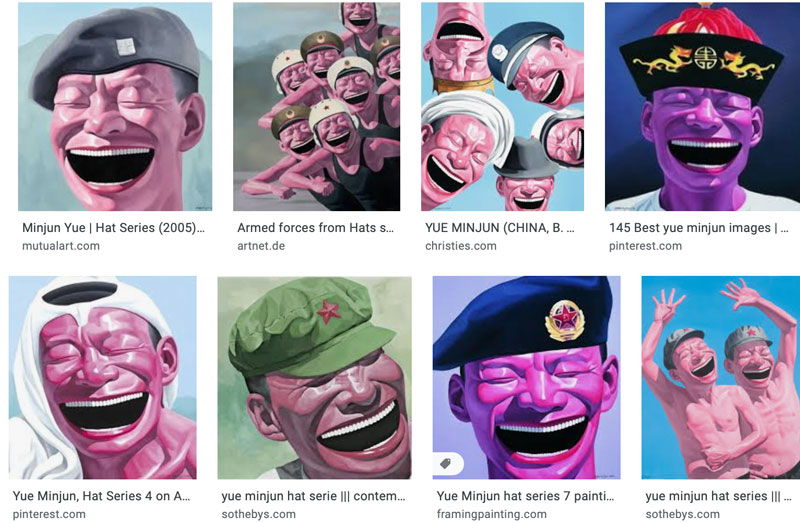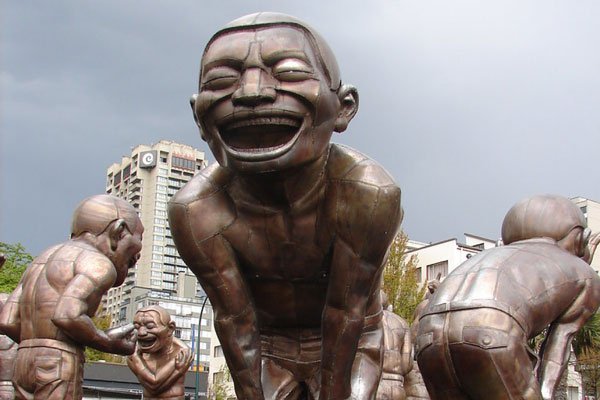Portrait of Yue Minjun
Yue Minjun’s legacy has been marked with a painting style that is jarringly beautiful, embodying the spirit of Chinese Cynical Realism although Minjun himself has dismissed this label on his art.
Born in 1962, Minjun grew up surrounded by oil fields and for a large part of his early life, working in the oil industry. Many consider this to be the main reason for his inclination towards oil paintings and the fact that he continued to draw portraiture of his friends as he worked justifies why he chooses pink to color skin with. However, the June 4th incident at Tiananmen Square and the following times brought Yue’s paintings to a greater height of importance. The laughing men with pink skin which covers the entirety of his canvases began to present a poignantly humorous and disturbingly real representation of post-Mao Chinese life.
The Beginning of the Laughing Men Paintings
Nearly all of Yue’s paintings have this particular figure reappearing: pink-skinned and bare-chested men with their mouths hanging open as they are locked in a perpetual moment of laughter. Immediately, one feels disturbed because the men seem to be laughing as if to mock those in front of them. According to Li Xianting, an art critic in contemporary Chinese paintings, these self-portraits of Minjun are a ‘self-ironic response to the spiritual vacuum and folly of modern-day China.’
Minjun’s artistic style developed quite frequently throughout his life, given to how he was always exposed to new environments and ideas from his continuous work-related traveling. Unlike other artists, however, Minjun didn’t simply absorb everything he learned but also challenged its conventions and created his own meaning through art.
Yue liked drawing the faces of his friends, and portraiture soon became Yue’s most prominent style of painting. In 1989, Yue visited an art show in Beijing where an artist named Geng Jianyi was exhibiting his self-portraitures. One of his paintings depicted Jianyi in a mid-laughter expression, and Yue took up great interest in this new style.
If you are interested in more about Yue Minjun check our artbook page.
Yue’s laughing figures always suggest a different underlying feeling in each painting. The 1997 painting titled Sky, for instance, shows a few men laughing while riding on cranes to an unknown destination. They all show feelings of merriment while being completely harmless in their transcendental journey and we look at the painting with awe and admiration.
However, the undertone in paintings such as the Mushroom Cloud and The Grassland Series Woodcut suggest something darker and sinister. It’s with these different undertones that Yue shows a great distinction between his paintings, despite having the figures of the men always repeated.
Yue’s Artistic Influences
Most of Yue’s drawings are related to Chinese history while some emulate famous Western paintings. However, the most popular of his paintings are the ones that represent his discourse with socio-political conventions.
In his art collection called the Hat, Yue draws a number of the laughing men figures wearing different hats. These hats are often used as the standard representation for certain professions, but Yue draws them with the intention of highlighting its sheer absurdity. What he means to show is how we are governed by these ‘socio-political protocols surrounding hats’ and it’s insane that such importance and distinction are placed on an item of clothing.

Yue does not shy away from imitating the works created by his Western influences. Instead, he keeps things as they are but alters the subjects to make the paintings entirely his own. This is shown in works such as the Massacre of Chios and The Execution of Emperor Maximilian. In both of these paintings, Yue copies the composition of the original Western work but places his own twist to produce a different meaning.
Many art critics have compared Yue’s laughing men figures as direct representations to the smiling Maitreya Buddha. This heavenly figure in Buddhism is distinguished by his perpetual smile. According to Buddhist eschatology, the Maitreya has looked into the future and appears to humans while laughing, hiding the pain of reality with laughter. This is a similar stance taken by Yue’s laughing figures, which attempt to dilute reality’s absurdity with laughter.
Cynical Realism for Yue Minjun
One of the most prominent Chinese contemporary artist, Li Xianting characterised Yue’s work as a true-to-name Cynical Realism. This idea of Cynical Realism was born in the emergence of the Cultural Revolution, prompted by the events of the 1989 Tiananmen Square Massacres.
Cynical Realism, by definition, refers to a general attitude of cynicism in the art that is produced to subvert political and societal behavior. This is something found profoundly in Yue’s work, where Li Xianting describes ‘Yue’s pieces are mocking himself and the community, free himself and vent his emotions.’
Yet, Yue stands firmly on his position against being one of the exemplary artists for Cynical Realism, ‘I’m actually trying to make sense of the world. There’s nothing cynical or absurd in what I do.’ While this does indicate that it’s wrong for others to title him as a great artist for Cynical Realism, Yue himself has remarked that the events of the Tiananmen Massacre have left a significant mark on his view of society, showing him the ‘gap between reality and the ideal.’
Current Whereabouts for Yue Minjun
Since his debut, Yue has gathered a huge following for his paintings and sculptures. He has even grabbed the limelight on his paintings and sculptures a number of times, amassing millions of dollars in revenue with his work. A few of his work has been exhibited overseas, with his first international highlight being in the 48th Venice Biennale.
Minjun currently lives with a group of 50 other artists in the village of Song Zhuang. His paintings and sculptures are still being displayed both in China and internationally, namely in places such as the Denver Art Museum, Shenzhen Art Museum, and the San Francisco Museum of Modern Art.
Yue’s paintings are incredibly surreal and this often makes its viewers feel uncomfortable. Yet, the subversive attitude that he displays with his work should not be something we turn our heads away from, but rather something we should look closely at and understand. To Yue, these paintings are a call for change and we should respond accordingly, ‘if you are faced with a situation you cannot change, then laughter may be the only possible reaction. But if many people start laughing, it can become a proactive force for change.’
psst… I hope you liked this Portrait of Chinese Artist Yue Minjun. If yes give it some social love and pin, like or share. Much appreciated!


